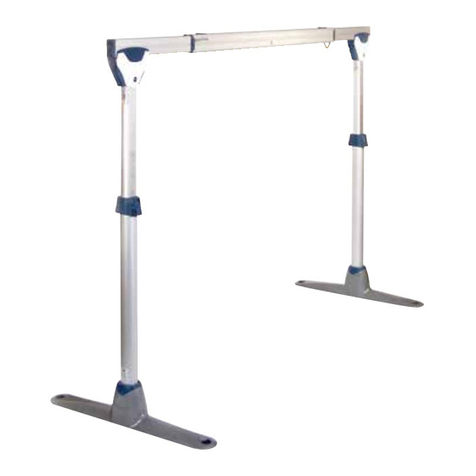BHM Medical Voyager Duo User manual

Voyager Duo
Instructions for Use
001.19520.EN rev.1
December 2009

Printed in Canada
BHM Medical Inc. reserves the right to change or discontinue any specifications, design, features,
model or accessories shown without notice.
TM Trade-mark of BHM Medical Inc. All rights reserved.
© BHM Medical Inc., 2009
The content of this publication may not be copied either whole or in part without the consent of BHM
Medical.Printed in Canada

3
Table of Contents
General Information ...............................................................................................5
Foreword .........................................................................................................5
Service and support ......................................................................................5
Manufacturer Information ............................................................................6
Authorized European Representative ...........................................................6
Definitions Used in this Manual ...................................................................6
Intended Use .................................................................................................6
Operational Life ...........................................................................................6
Equipment Identification ..............................................................................7
Verifying the Package Contents ...................................................................7
How to Use this Manual ...............................................................................7
Symbols Used .................................................................................................8
Safety Instructions...................................................................................................9
General Instructions ........................................................................................9
Safe Working Load ......................................................................................9
Important Safety Directions .........................................................................10
Shock Prevention ..........................................................................................10
Fire and Explosion Prevention .....................................................................11
Human and Environmental Safety Practices ................................................11
Battery and Battery Charger Safety Practices ................................................. 11
Equipment Warning Labels ..........................................................................11
Part Designation ......................................................................................................12
Hand control .................................................................................................... 13
Charger ............................................................................................................13
Slings......................................................................................................................... 14
How to Use the Voyager Duo..................................................................................15
Return to Charge (RTC) ...............................................................................16
Emergency Stop (red cord) ..........................................................................16
Emergency Lowering ...................................................................................16
Emergency Brake .........................................................................................16
Battery Information ......................................................................................... 18
Indicator Lights ............................................................................................18
Charging the Batteries ..................................................................................18
Using the FIDO Function (Pre-Programmed Positions) .................................20
Use of Slings ................................................................................................... 20
Spreader Bars and Stretcher Frame ..............................................................20
Slings ............................................................................................................20
Before Approaching the Patient ...................................................................20
Programming the Ceiling Lift .........................................................................20
Changing the Speed of Movement ...............................................................21

4
Table of Contents
Voyager Duo Programming.................................................................................... 21
Adjusting the Spreader Bar Height ..............................................................22
Enable/Disable Return to Charge (RTC) .....................................................23
Care and Maintenance............................................................................................24
Preventive Maintenance Schedule ..................................................................24
User Inspections .............................................................................................. 24
Inspections by an Authorized Service Technician .......................................... 25
Daily Checklist ................................................................................................ 27
Inspection and Cleaning ...............................................................................27
Strap Inspection ............................................................................................27
Handling and Storage ...................................................................................... 28
Battery Replacement ....................................................................................28
Verification of the Charger’s Power Source ................................................28
Sling Inspection ............................................................................................28
Annual Inspection ........................................................................................... 28
Maintenance Requirements ..........................................................................28
Troubleshooting.......................................................................................................29
Labels on the Lift.....................................................................................................31
Technical Specifications.......................................................................................... 32
Lift Dimensions ........................................................................................................ 34
Electromagnetic Compatibility ..............................................................................35
Electromagnetic Compliance .......................................................................... 35
Electromagnetic Emissions ............................................................................. 35
Electromagnetic Immunity .............................................................................. 36
Limited Warranty ...................................................................................................39

5
General Information
Thank you for purchasing the
BHM Voyager Duo ceiling lift.
Your Voyager Duo is part of a
series of quality products
designed specially for home
care, nursing homes and other
health care uses.
We are dedicated to serving your
needs and providing the best
products available along with
training that will bring your staff
maximum benefits from every
BHM Medical product.
Please read this manual
thoroughly and contact us if you
have any questions about the
operation or maintenance of
your BHM Medical equipment.
Foreword
Please read this manual in its entirety before using your
Voyager Duo. The information in this manual is crucial to
the proper operation and maintenance of the equipment and
will help protect your product as well as ensure that the
equipment performs to your satisfaction. Lifting and
transferring a person always presents a potential risk. Some
of the information in this manual is important for your
safety and must be read and understood to help prevent
injuries. BHM Medical strongly advises and warns that to
avoid injuries that can be attributed to the use of inadequate
parts, only parts designated by BHM Medical should be
used on equipment and other appliances supplied by
BHM Medical.
Furthermore, unauthorized modifications on any
BHM Medical equipment may affect its safety.
BHM Medical will not be held responsible for any
accidents, incidents or deficiencies of performance that
occur as a result of any unauthorized modification to its
products.
Tested according to standards by:
Product Service and
Service and support
A service routine must be performed on your Voyager Duo
by BHM Medical certified service personnel. This will
ensure the safety and good functioning of your product.
See section called “Care and Maintenance” in this manual.
If you require further information, please contact your local
BHM Medical representative which can offer
comprehensive support and service programs to maximize
the long-term reliability, safety and value of the product.
Contact your local BHM Medical representative for
replacement parts.
Additional copies of this manual can be purchased from
your local BHM Medical representative. When ordering,
include the Instructions for Use product number (see front
page) and equipment identification number.
Table of contents
Other BHM Medical Mobility Aid manuals
Popular Mobility Aid manuals by other brands

Decon wheel
Decon wheel TNS Notos Assembly instructions

ExoAtlet
ExoAtlet ExoAtlet-II user manual

Invacare
Invacare Storm Series parts catalog

Rhythm Healthcare
Rhythm Healthcare B3800F manual

AMF-BRUNS
AMF-BRUNS PROTEKTOR installation manual

Drive DeVilbiss Healthcare
Drive DeVilbiss Healthcare OTTER Instructions for use













